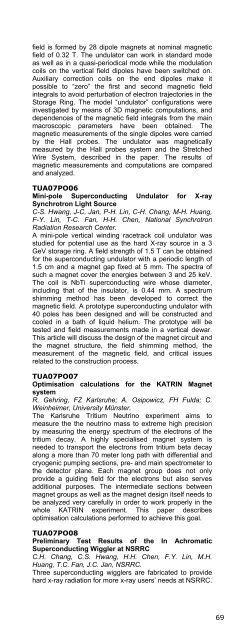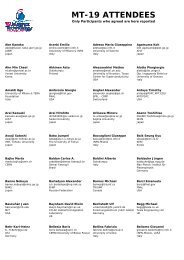Click here to download the abstract booklet in pdf format - MT19 - Infn
Click here to download the abstract booklet in pdf format - MT19 - Infn
Click here to download the abstract booklet in pdf format - MT19 - Infn
You also want an ePaper? Increase the reach of your titles
YUMPU automatically turns print PDFs into web optimized ePapers that Google loves.
field is formed by 28 dipole magnets at nom<strong>in</strong>al magnetic<br />
field of 0.32 T. The undula<strong>to</strong>r can work <strong>in</strong> standard mode<br />
as well as <strong>in</strong> a quasi-periodical mode while <strong>the</strong> modulation<br />
coils on <strong>the</strong> vertical field dipoles have been switched on.<br />
Auxiliary correction coils on <strong>the</strong> end dipoles make it<br />
possible <strong>to</strong> “zero” <strong>the</strong> first and second magnetic field<br />
<strong>in</strong>tegrals <strong>to</strong> avoid perturbation of electron trajec<strong>to</strong>ries <strong>in</strong> <strong>the</strong><br />
S<strong>to</strong>rage R<strong>in</strong>g. The model “undula<strong>to</strong>r” configurations were<br />
<strong>in</strong>vestigated by means of 3D magnetic computations, and<br />
dependences of <strong>the</strong> magnetic field <strong>in</strong>tegrals from <strong>the</strong> ma<strong>in</strong><br />
macroscopic parameters have been obta<strong>in</strong>ed. The<br />
magnetic measurements of <strong>the</strong> s<strong>in</strong>gle dipoles were carried<br />
by <strong>the</strong> Hall probes. The undula<strong>to</strong>r was magnetically<br />
measured by <strong>the</strong> Hall probes system and <strong>the</strong> Stretched<br />
Wire System, described <strong>in</strong> <strong>the</strong> paper. The results of<br />
magnetic measurements and computations are compared<br />
and analyzed.<br />
TUA07PO06<br />
M<strong>in</strong>i-pole Superconduct<strong>in</strong>g Undula<strong>to</strong>r for X-ray<br />
Synchrotron Light Source<br />
C-S. Hwang, J-C. Jan, P-H. L<strong>in</strong>, C-H. Chang, M-H. Huang,<br />
F-Y. L<strong>in</strong>, T-C. Fan, H-H. Chen, National Synchrotron<br />
Radiation Research Center.<br />
A m<strong>in</strong>i-pole vertical w<strong>in</strong>d<strong>in</strong>g racetrack coil undula<strong>to</strong>r was<br />
studied for potential use as <strong>the</strong> hard X-ray source <strong>in</strong> a 3<br />
GeV s<strong>to</strong>rage r<strong>in</strong>g. A field strength of 1.5 T can be obta<strong>in</strong>ed<br />
for <strong>the</strong> superconduct<strong>in</strong>g undula<strong>to</strong>r with a periodic length of<br />
1.5 cm and a magnet gap fixed at 5 mm. The spectra of<br />
such a magnet cover <strong>the</strong> energies between 3 and 25 keV.<br />
The coil is NbTi superconduct<strong>in</strong>g wire whose diameter,<br />
<strong>in</strong>clud<strong>in</strong>g that of <strong>the</strong> <strong>in</strong>sula<strong>to</strong>r, is 0.44 mm. A spectrum<br />
shimm<strong>in</strong>g method has been developed <strong>to</strong> correct <strong>the</strong><br />
magnetic field. A pro<strong>to</strong>type superconduct<strong>in</strong>g undula<strong>to</strong>r with<br />
40 poles has been designed and will be constructed and<br />
cooled <strong>in</strong> a bath of liquid helium. The pro<strong>to</strong>type will be<br />
tested and field measurements made <strong>in</strong> a vertical dewar.<br />
This article will discuss <strong>the</strong> design of <strong>the</strong> magnet circuit and<br />
<strong>the</strong> magnet structure, <strong>the</strong> field shimm<strong>in</strong>g method, <strong>the</strong><br />
measurement of <strong>the</strong> magnetic field, and critical issues<br />
related <strong>to</strong> <strong>the</strong> construction process.<br />
TUA07PO07<br />
Optimisation calculations for <strong>the</strong> KATRIN Magnet<br />
system<br />
R. Gehr<strong>in</strong>g, FZ Karlsruhe; A. Osipowicz, FH Fulda; C.<br />
We<strong>in</strong>heimer, University Münster.<br />
The Karlsruhe Tritium Neutr<strong>in</strong>o experiment aims <strong>to</strong><br />
measure <strong>the</strong> <strong>the</strong> neutr<strong>in</strong>o mass <strong>to</strong> extreme high precision<br />
by measur<strong>in</strong>g <strong>the</strong> energy spectrum of <strong>the</strong> electrons of <strong>the</strong><br />
tritium decay. A highly specialised magnet system is<br />
needed <strong>to</strong> transport <strong>the</strong> electrons from tritium beta decay<br />
along a more than 70 meter long path with differential and<br />
cryogenic pump<strong>in</strong>g sections, pre- and ma<strong>in</strong> spectrometer <strong>to</strong><br />
<strong>the</strong> detec<strong>to</strong>r plane. Each magnet group does not only<br />
provide a guid<strong>in</strong>g field for <strong>the</strong> electrons but also serves<br />
additional purposes. The <strong>in</strong>termediate sections between<br />
magnet groups as well as <strong>the</strong> magnet design itself needs <strong>to</strong><br />
be analyzed very carefully <strong>in</strong> order <strong>to</strong> work properly <strong>in</strong> <strong>the</strong><br />
whole KATRIN experiment. This paper describes<br />
optimisation calculations performed <strong>to</strong> achieve this goal.<br />
TUA07PO08<br />
Prelim<strong>in</strong>ary Test Results of <strong>the</strong> In Achromatic<br />
Superconduct<strong>in</strong>g Wiggler at NSRRC<br />
C.H. Chang, C.S. Hwang, H.H. Chen, F.Y. L<strong>in</strong>, M.H.<br />
Huang, T.C. Fan, J.C. Jan, NSRRC.<br />
Three superconduct<strong>in</strong>g wigglers are fabricated <strong>to</strong> provide<br />
hard x-ray radiation for more x-ray users’ needs at NSRRC.<br />
The design effective wiggler field is 3.1 T for a 61-mm<br />
period at pole gap width of 19 mm. 16 racetrack-shaped<br />
coils, made of high perform<strong>in</strong>g NbTi, are enclosed and<br />
prestressed <strong>in</strong> an alum<strong>in</strong>um hous<strong>in</strong>g. The design of magnet<br />
and cryostat system is described <strong>in</strong> this work. The<br />
magnetic pole has important magnetic function. 5-pole<br />
pro<strong>to</strong>type magnets with various pole materials from low<br />
carbon steel, vanadium permendure steel and holmium are<br />
tested and verified <strong>the</strong> magnetic field performance. We<br />
present <strong>the</strong> performances of <strong>the</strong> pro<strong>to</strong>type of compact<br />
superconduct<strong>in</strong>g wiggler.<br />
TUA07PO09<br />
Manufacture and test of <strong>the</strong> 5T superconduct<strong>in</strong>g<br />
undula<strong>to</strong>r for <strong>the</strong> LHC synchrotron radiation profile<br />
moni<strong>to</strong>r<br />
R. Maccaferri, D. Tommas<strong>in</strong>i, W. Ventur<strong>in</strong>i Delsolaro, S.<br />
Bet<strong>to</strong>ni, CERN.<br />
NbTi superconduct<strong>in</strong>g undula<strong>to</strong>rs will be used <strong>in</strong> <strong>the</strong> LHC<br />
as a key part of <strong>the</strong> Synchrotron Radiation Profile Moni<strong>to</strong>r<br />
System. Two undula<strong>to</strong>rs are needed, one per each<br />
circulat<strong>in</strong>g beam, provid<strong>in</strong>g 5 T <strong>in</strong> a 60 mm bore over two<br />
periods of 280 mm each. A full scale pro<strong>to</strong>type has been<br />
designed and successfully tested <strong>in</strong> <strong>the</strong> end of 2004. In this<br />
paper, <strong>the</strong> electromagnetic and <strong>the</strong> mechanical design of<br />
<strong>the</strong> undula<strong>to</strong>r are summarized. The fabrication of <strong>the</strong><br />
pro<strong>to</strong>type is described and <strong>the</strong> cold test results, both power<br />
test and field measurements, are reported.<br />
TUA07PO10<br />
Design of <strong>the</strong> PETRA III Damp<strong>in</strong>g Wiggler<br />
P.D. Vobly, A. Utk<strong>in</strong>, N. Khav<strong>in</strong>, E. Levichev, N. Zubkov,<br />
BINP; M. Tisher, DESY.<br />
The proposed upgrade of <strong>the</strong> PETRA s<strong>to</strong>rage r<strong>in</strong>g will<br />
provide <strong>the</strong> horizontal emittance of ~1 nm if a number of<br />
damp<strong>in</strong>g wigglers with a <strong>to</strong>tal length about 80 m are<br />
<strong>in</strong>stalled <strong>in</strong> two long straight sections. The paper describes<br />
design concept of <strong>the</strong> damp<strong>in</strong>g wiggler, optimization of its<br />
parameters and results of <strong>the</strong> pro<strong>to</strong>type magnetic<br />
measurements.<br />
TUA07PO11<br />
Extend<strong>in</strong>g Electromagnetic Wiggler/Undula<strong>to</strong>r Magnet<br />
made with Sheet Copper Coils <strong>to</strong> Shorter Periods<br />
G.H. Biallas, S. Benson, T. Hiatt, G. Neil, M. Snyder<br />
TJNAF.<br />
Withdrawn.<br />
TUA07PO12<br />
The bend<strong>in</strong>g magnets for <strong>the</strong> pro<strong>to</strong>n transfer l<strong>in</strong>e of<br />
CNGS<br />
K.M. Schirm, CERN; Y. Pupkov, V. Anash<strong>in</strong>, A. Ogurtsov,<br />
E. Ruv<strong>in</strong>sky, K. Zhilyaev, V. Maraev, O. Kiselev, BINP; Y.<br />
Konstant<strong>in</strong>ov, V. Peregud, EFREMOV.<br />
The project “CERN neutr<strong>in</strong>os <strong>to</strong> Gran Sasso (CNGS)”, a<br />
collaboration between CERN and <strong>the</strong> INFN (Gran Sasso<br />
Labora<strong>to</strong>ry) <strong>in</strong> Italy, will study neutr<strong>in</strong>o oscillations <strong>in</strong> a long<br />
base-l<strong>in</strong>e experiment. High energy pro<strong>to</strong>ns will be extracted<br />
from <strong>the</strong> CERN SPS accelera<strong>to</strong>r, transported through a<br />
727 m long transfer l<strong>in</strong>e and focussed on<strong>to</strong> a graphite<br />
target <strong>to</strong> produce a beam of pions and kaons and<br />
subsequently neutr<strong>in</strong>os. The transfer l<strong>in</strong>e requires a <strong>to</strong>tal of<br />
78 dipole magnets. They were produced <strong>in</strong> <strong>the</strong> framework<br />
of an <strong>in</strong>-k<strong>in</strong>d contribution of Germany via (3)DESY <strong>to</strong> <strong>the</strong><br />
CNGS project. The classical dipoles, built from lam<strong>in</strong>ated<br />
steel cores and copper coils, have a core length of 6.3 m, a<br />
37 mm gap height and a nom<strong>in</strong>al field range of 1.38 T –<br />
1.91 T at a maximum current of 4950 A. The magnet was<br />
designed <strong>in</strong> collaboration between (2)CERN and (1)BINP.<br />
69 MT-19 2005, Genova



